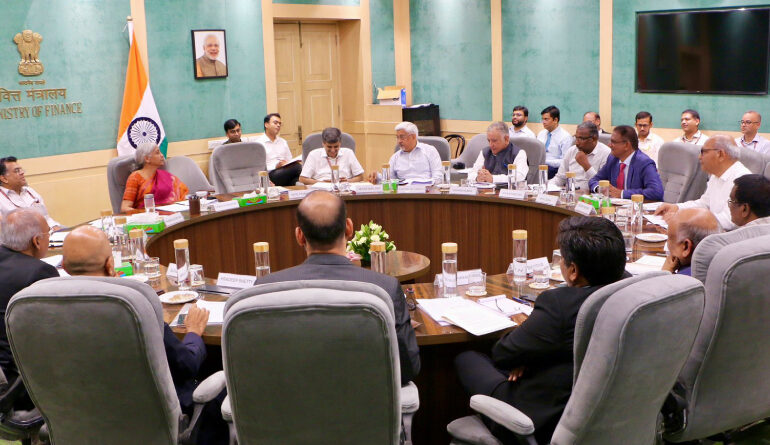
GJEPC Chairman Shri Vipul Shah presented key recommendations for the gem and jewellery trade at today’s pre-budget meeting with Union Finance Minister Smt. Nirmala Sitharaman.
Mr. Vipul Shah, Chairman of GJEPC, highlighted the significant contribution of the Indian gems and jewellery industry, which accounts for around 10% of India’s total merchandise exports. He emphasized the current challenges faced by the industry due to the geopolitical scenario, the emergence of the beneficiation scheme, and issues related to rough diamond sourcing. Given the macroeconomic context, he urged the government to take measures to revive exports in this sector. He requested the Hon’ble Finance Minister to introduce a Safe Harbour rule in SNZs, introduce the Diamond Imprest License, reduce the import duty on gold, silver, and platinum bars to 4%, and introduce duty drawback on exports of platinum jewellery to leverage the India UAE CEPA. These measures are crucial for giving a competitive edge to the industry, boosting exports, and generating employment.
GJEPC’s Pre-Budget Recommendations:
1. Sale of Rough Diamonds in Special Notified Zones (SNZs): GJEPC has urged the Government to consider its long-pending demand for the sale of rough diamonds in Special Notified Zones (SNZs) through the Safe Harbour Rule and to expand the scope of entities entitled to operate through SNZs. Currently, only viewing sessions are held by mining countries at SNZs. SNZs were established to ensure the easy availability of rough diamonds by allowing overseas diamond mining companies to sell their produce directly to Indian manufacturers.
In countries like Belgium and Dubai, the sale of rough diamonds is permitted without direct tax or with minimal turnover tax. However, Indian bidders currently cannot purchase rough diamonds from SNZs due to the lack of a waiver under section 9(1)(i) of the Income-Tax Law.
2. Establishment of SNZ for Rough Gemstones in Jaipur: GJEPC has proposed the establishment of an SNZ for rough gemstones in Jaipur. With SNZs in Mumbai, Surat, and Jaipur, the critical issue of raw material availability would be greatly relieved.
3. Facilitating Rough Diamond Broking and Trading Companies at SNZ: GJEPC requested the Government to allow globally recognized diamond broking/trading houses, such as Bonas and I Hennig, to operate from SNZs. These trading houses are pivotal for the sale of diamonds from smaller miners, which account for close to 35% of global mining production. Allowing these trading houses to operate from SNZs would ensure India’s flexible, timely, and cost-efficient access to such diamonds.
4. Introduction of Diamond Imprest License: Under the beneficiation scheme, some mining countries do not allow the export of rough diamonds without some value addition (cutting). These diamonds, when imported to India, are treated as cut and polished diamonds, attracting a 5% Basic Customs Duty (BCD), making Indian exports less competitive. GJEPC suggests reintroducing the Diamond Imprest License to allow Indian diamond exporters to import a certain percentage of their average export turnover from the preceding three years, providing a level playing field for MSME diamond exporters.
5. Reduction in Import Duty on Precious Metals to 4%: GJEPC has sought a reduction in import duty on gold bars (7108) from 15% to 4%, silver bars (7106) from 10% to 4%, and platinum bars (7110) from 12.5% to 4%. This would release blocked duties, resulting in more working capital for the industry and unlocking the untapped export potential of gold jewellery.
6. Introducing Duty Drawback on Exports of Platinum Jewellery: Due to high import duties and non-availability of duty-free platinum from nominated agencies/banks, DTA exporters face constraints, resulting in most platinum jewellery exports happening through SEZs. GJEPC recommends introducing a duty drawback for platinum jewellery to enhance competitiveness in the international market.
The Importance of the Indian Gem and Jewellery Industry:
India’s gem and jewellery industry relies heavily on imports of raw materials like gold, diamonds, silver, and colored gemstones, which are processed and exported globally. This industry supports approximately 4.3 million jobs, contributes about 10% to the country’s merchandise exports, and significantly impacts overall economic growth. India has established itself as a leading global source for gems and jewellery. To maintain this position, the industry requires strategic policy interventions to remain competitive.
About The Gem and Jewellery Export Promotion Council (GJEPC):
The Gem & Jewellery Export Promotion Council (GJEPC), established by the Ministry of Commerce, Government of India, in 1966, is the apex body of the gems and jewellery industry. With headquarters in Mumbai and regional offices in New Delhi, Kolkata, Chennai, Surat, and Jaipur, GJEPC represents 10,000 members and plays a crucial role in promoting India’s gem and jewellery exports.
Image Courtesy: GJEPC
Disclaimer: Jewel Bharat aims to provide accurate and reliable information. Readers are encouraged to contact@jewelbharat.com to report any concerns regarding the content. Appropriate corrective measures, including potential removal of the article from the website, will be taken following investigation.




